Hart's-tongue Fern
Hart's-tongue Fern is a medium-sized fern that can be found growing in damp, shady gorges and banks in woodlands, as well as on rocks, walls and mossy branches. They are hardy plants and are ideal for gardens; plant them in shade under trees or on walls or gravelly areas for attractive cover all year-round.
Our gardens are a vital resource for local wildlife, providing corridors of green space between open countryside, allowing species to move about. In fact, the UK's gardens provide more space for nature than all the National Nature Reserves put together. So why not try planting native plants and trees to encourage birds, mammals and invertebrates into your backyard? To find out more about wildlife-friendly gardening, visit our Wild About Gardens website: a joint initiative with the RHS, there's plenty of facts and tips to get you started.
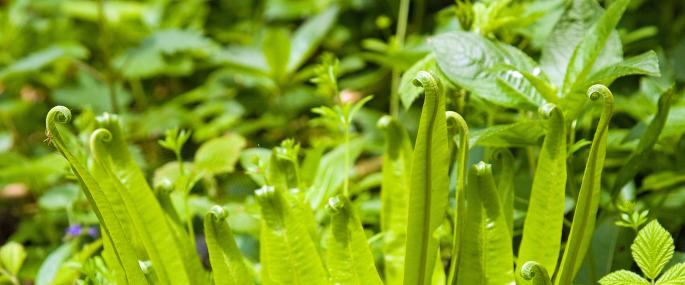
Bracken
Bracken is the UK's most common fern and grows in dense stands on heathland, moorland, hillsides and in woodland. It is a large fern that favours dry, acid soils and spreads by underground rhizomes. Unlike many ferns, Bracken dies back in winter, leaving brown withered fronds that pepper the landscape. In the spring, the tightly curled fronds appear, grow and unfurl.
Bracken is a highly invasive plant and can be damaging to sensitive habitats if it is allowed to spread as it can shade out other, rarer plants. The Wildlife Trusts ensure that the habitats they manage are well-balanced through a number of conservation measures including removing overpowering species like Bracken, scrub-cutting and controlled grazing. You can help too: volunteer for your local Wildlife Trust and you could be involved in everything from stockwatching to raising awareness about wildlife.
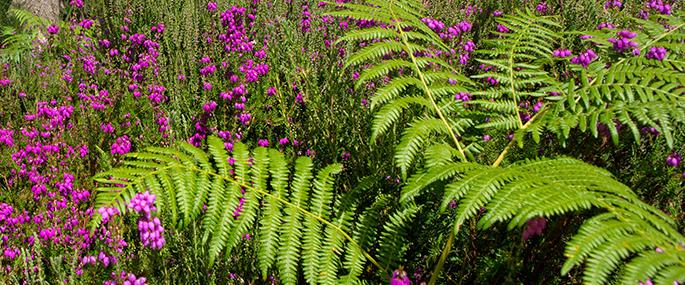
Polypody
The Common Polypody is a medium-sized fern which is characteristic of damp, shady gorges and banks in woodlands, as well as rocks, walls and mossy branches. They can also survive in quite dry conditions and are ideal for gardens; plant them in shade under trees or on walls or gravelly areas for attractive cover.
Our gardens are a vital resource for local wildlife, providing corridors of green space between open countryside, allowing species to move about. In fact, the UK's gardens provide more space for nature than all the National Nature Reserves put together. So why not try planting native plants and trees to encourage birds, mammals and invertebrates into your backyard? To find out more about wildlife-friendly gardening, visit our Wild About Gardens website: a joint initiative with the RHS, there's plenty of facts and tips to get you started.

Parsley Fern
Parsley Fern is a medium-sized, bushy fern of rocky places on hillsides and slopes in the uplands. It is widespread but generally quite scarce, apart from in Snowdonia and the Lake District.
The Wildlife Trusts manage many heathland and upland habitats sympathetically for the benefit of all kinds of wildlife. We are also working closely with farmers, landowners and developers to promote wildlife-friendly practices. We have a vision of a 'Living Landscape': a network of habitats and wildlife corridors across town and country, which are good for both wildlife and people. You can support this greener vision for the future by joining your local Wildlife Trust.
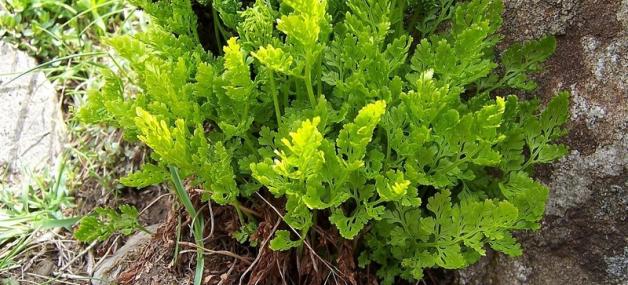
Adder's-tongue Fern
Adder's-tongue Fern is an unusual fern that grows in old grasslands, on hillsides, along woodland rides and on sand dunes. It usually appears between June and August, spending the rest of the year underground as a rhizome. It is considered a good indicator species of ancient meadows and can be found alongside Common Spotted-orchids, Quaking Grass and Devil's-bit Scabious.
The Wildlife Trusts manage many grassland and woodland edge habitats sympathetically for the benefit of all kinds of species, including the Adder's-tongue Fern. Careful grazing with traditional breeds, hay-cutting at the right time and scrub clearance are just some of the ways grasslands are kept in good condition - supporting numerous plants and invertebrates and, in turn, the larger animals that eat them. By volunteering for your local Trust you can help too, and you'll make new friends and learn new skills along the way.
Ordinary Moss
Ordinary Moss, as its name suggests, is one of the UK's most common mosses and is found growing in lawns, on damp ground and in woodlands.
Moss provides important shelter and food for many of our minibeasts and can be encouraged to grow in the garden by providing logs, stone piles and untidy areas. In turn, other species, such as birds, mammals and amphibians, will be attracted to the garden looking for a minibeast meal. To find out more about encouraging wildlife into your garden, visit our Wild About Gardens website: a joint initiative with the RHS, there's plenty of facts and tips to get you started.
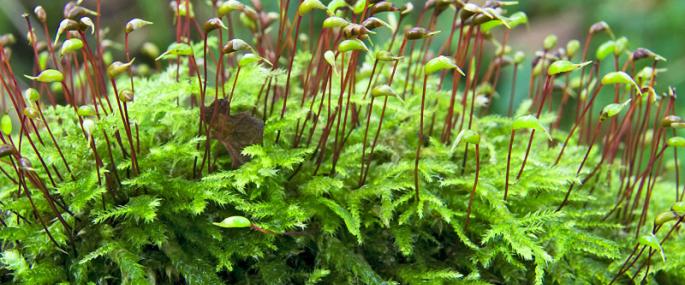
Sphagnum Moss
Sphagnum mosses are the amazingly multi-coloured living carpets of moss found in wet places like peat bogs, marshland, heath and moorland. When seen up close, they are very beautiful, but they also play a very important role in the creation of peat bogs: they hold water in their spongy forms long after the surrounding soil has dried out. In this way, they provide essential nutrients to the soil and help to prevent the decay of dead plant material which gets compressed over hundreds of years to form peat.
Peat is a precious resource that can take thousands of years to form and peat bogs are important habitats for a whole range of species from Sphagnum mosses to Bog Bush-crickets, Hen Harriers to Adders. However, our peat bogs have been overexploited by the commercial extraction of peat, particularly for horticulture. You can help these precious habitats: buy peat-free products for your garden, make your own compost and don't buy plants grown in peat. These simple measures can help save our rare and fascinating peat bogs. To find out more about peat-free gardening download our simple guide.

Fir Clubmoss
Clubmosses are very primitive plants found in rocky habitats, moorland, bogs and mountains. Fir Clubmoss is a tufted, upright fern ally that is particularly common in Scotland, but can be found amongst rocks and on bare ground in upland areas around the UK.
The Wildlife Trusts manage many heathland and upland habitats sympathetically for the benefit of all kinds of wildlife. We are also working closely with farmers, landowners and developers to promote wildlife-friendly practices. We have a vision of a 'Living Landscape': a network of habitats and wildlife corridors across town and country, which are good for both wildlife and people. You can support this greener vision for the future by joining your local Wildlife Trust.
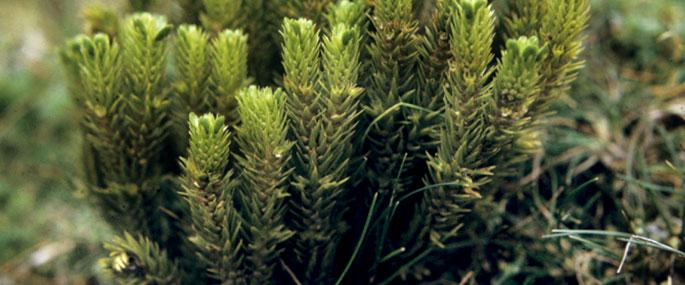
Marsh Hair Moss
The largest moss in the UK, Marsh Hair Moss grows in damp woodland and ditches, and on heaths and moorland. It grows relatively tall and often forms large 'cushions' or hummocks. The fruiting bodies appear in summer - the capsules are borne on a long, red stem and covered by 'calyptra' (capsule covers).
The Wildlife Trusts recognise the importance of healthy habitats to support all kinds of species, so manage many nature reserves for the benefit of all kinds of wildlife. But these precious sites are under threat from development, intensive agricultural practices and climate change. You can help by supporting your local Trust and becoming a member; you'll find out about exciting wildlife happenings, events on your doorstep and volunteering opportunities, and be helping local wildlife along the way.
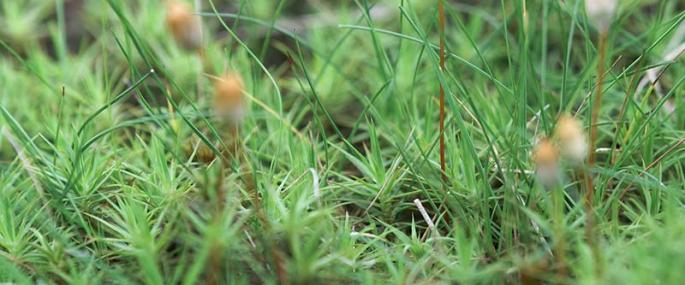
Mackerel
A streamlined, fast-swimming fish, with a deeply forked tail, the Mackerel migrates to shallower waters during the summer. Mackerel 'school', forming large groups that appear to move as one. They feed on small fish, such as sand eels, but spend the winter in deep water where they stop feeding.
Mackerel are a commercially important species and declined severely during the 1960s due to overfishing - a threat which continues today. You can help by being careful about what you choose in the supermarket - go for sustainably produced fish and shellfish, preferably with the Marine Stewardship Council's logo. The Wildlife Trusts are working with fishermen, researchers, politicians and local people towards a vision of 'Living Seas', where marine wildlife thrives.
